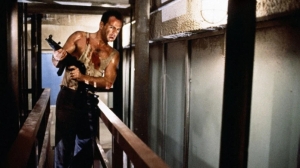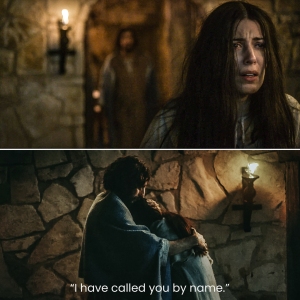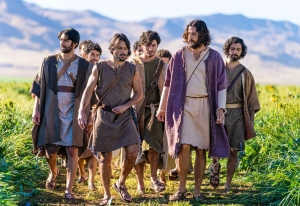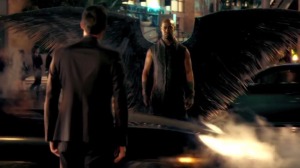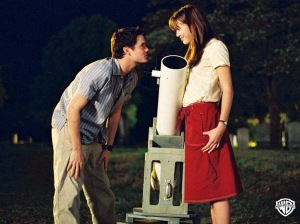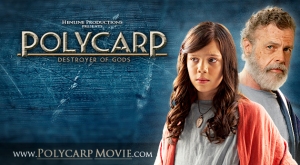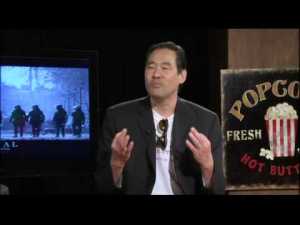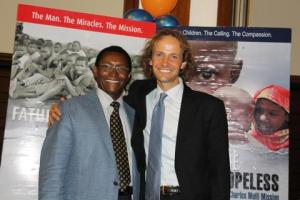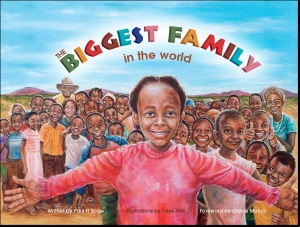Paul Boge gets it. He runs the Winnipeg Real to Reel Film Festival like, well, a film festival. Just because the films are shown in a church and are mainly new offerings on the market from what might be loosely called the Christian movie genre – a hot genre even in secular Hollywood these days – Boge doesn’t give them a free pass, as it were. If your film has copyrighted music or other material subject to copyright protection and you’re a filmmaker, you better have arranged all the necessary copyright clearances, or it won’t be screening this week at North Kildonan Mennonite Brethren Church on Gateway Road in Winnipeg. Boge, a consulting mining engineer and capital project manager with the family firm Boge & Boge Consulting Engineers in Winnipeg, wears many hats, and is a member of the church.
This year’s festival runs on four screens from today through Feb. 21, opening at 7 p.m. with three flicks, including A Matter of Faith, from Rich Christiano’s Five & Two Pictures, where a college classroom clash between a biblical creation-believing freshman and a professor teaching evolution (a popular theme in the last few years, also canvassed in God’s Not Dead and God’s Not Dead 2, being released in April) is showing in Theatre 1. You can watch a YouTube trailer for A Matter of Faith here at: https://www.youtube.com/watch?v=yiRGdJ2uPwk Christiano, a former Catholic from Waterloo, New York, became a born-again Christian in 1980. One of his early influences after his conversion experience was John MacArthur, pastor of Grace Community Church.
Two of the other feature films showing at this year’s festival are Henline Productions of Loveland, Ohio’s Polycarp: Destroyer of Gods, based on a novel authored by Pastor Rick Lambert, a co-pastor of Grace Bible Church in Cincinnati, and War Room, from Alex and Stephen Kendrick.
St. Polycarp, one of the three chief Apostolic Fathers, was a second century bishop of Smyrna, one of the new centres for the Christian world after the fall of Jerusalem in 70 AD, and located in modern-day Turkey on the Aegean Sea, was martyred at the age of 86 in 155 AD on the orders of Statius Quadratus, proconsul of Asia.
Born in 69 AD, the real-life Polycarp was an important historical link to that Sub-Apostolic Age, during which it was possible to learn by word of mouth what the Apostles taught from those who had heard them for themselves.
But sorting out fact from fiction when it comes to the life of Polycarp of Smyrna, like so many ancient saints from the Sub-Apostolic Age, is no simple task. Much is simply shrouded in the mists of time and certainties are in short supply. Even the historical fact that Statius Quadratus was the proconsul of Asia at the time who ordered Polycarp’s martyrdom is not beyond dispute, nor is the exact year of Polycarp’s death. Quintus Septimius Florens Tertullianus wrote it was St. John the Apostle himself who made Polycarp a bishop.
The main sources of credible historical information concerning St. Polycarp are the Epistles of St. Ignatius; Polycarp’s own Epistle to the Philippians; sundry passages in St. Irenaaus; and the Letter of the Smyrnwans recounting the martyrdom of St. Polycarp. The Epistle of St. Polycarp was a reply to one from the Philippians, in which they had asked him to address them some words of exhortation.
Four out of the seven genuine epistles of St. Ignatius were written from Smyrna. In two of these – Magnesians and Ephesians – he speaks of Polycarp. The seventh Epistle was addressed to Polycarp.
Just before his martyrdom in 155 AD, Polycarp was urged by Quadratus, or whoever the proconsul was, to curse Christ, leading to Polycarp’s celebrated reply: “Fourscore and six years have I served Him, and He has done me no harm. How then can I curse my King that saved me?” Polycarp was then burned and stabbed to death.
Henline Productions, formerly J&J Productions, is the brother and sister Protestant evangelical homeschooled filmmaking team of Joe Henline, 20, and Jerica Henline, 22.
In 2010, they entered the five-minute short video No Time in the San Antonio Independent Christian Film Festival and finished as semi-finalists in the competition.
Their next film, The Forgotten Martyr: Lady Jane Grey, shot in 2011 was entered into the 2012 San Antonio Independent Christian Film Festival and won them the Best Young Filmmaker award, and was runner-up in the Short Film category. Awards from other independent Christian film festivals included, Best Young Filmmaker at the GloryReelz Christian Film Festival, Golden Crown Award (Best Student Production) at the International Christian Visual Media Festival and Best Young Filmmaker at The Attic Film Festival.
In their script for Polycarp, a 12-year-old slave girl, Anna, is rescued and adopted by Christians in 2nd century Smyrna and befriended by the aged Polycarp. You can watch a brief 1:52 YouTube trailer for it here at: https://www.youtube.com/watch?v=7IjPlffZVy8
In real life, of course, Polycarp was supposedly born into slavery, purchased as a young boy, and raised by a godly woman in Ephesus.
As Anna is taught by Polycarp and her new family, she struggles to reconcile her beliefs with those of the Christians. When the Roman proconsul demands that all citizens worship Caesar to show their allegiance to Rome, Polycarp and the Christians stand for their faith against the growing threat of persecution, and Anna is forced to choose whom she is willing to live – and die – for.
Polycarp was awarded Best Feature Film, Audience Choice Award and Best Original Music Score at the second Christian Worldview Film Festival last March at Castle Hills First Baptist Church, also in San Antonio.
Tulsa native Garry Nation received the award for Best Lead Actor in a Feature Film for his performance as Polycarp.
A family-friendly drama, War Room is about learning to fight the right kinds of battles. Filled with humor, wit and heart, it follows Tony and Elizabeth Jordan, a middle-class couple, and their daughter, Danielle, as they struggle through personal, marital and spiritual issues. Their lives are forever changed after Elizabeth meets an elderly widow who helps her develop a secret prayer room in her home. You can watch a YouTube trailer for it here at: https://www.youtube.com/watch?v=mIl-XY9t_Lw
The Kendricks, who are both associate pastors on the staff of Sherwood Baptist Church in Albany, Georgia, got their start in 2003 with their first movie Flywheel. They conceived the idea for Flywheel in the spring of 2002 after they saw the results from Barna Research Group demonstrating empirically popular culture movies and television shows are more influential in American society than the Christian church.
Flywheel, which tells the story of a dishonest used car salesman who comes to grips with his need for God, relied on untrained actors from the Sherwood Baptist Church congregation to play all the roles, debuting as an independent film on a single Carmike Theatre screen in Albany, Georgia in April 2003 and ran for six weeks initially, often outdrawing Hollywood films on adjoining screens.
Then came Facing the Giants in 2006 and in 2008 Fireproof, made on a $500,000 budget, but generating more than $33.4 million at the box office, making it the highest-grossing independent film of the year. Their most recent film until the release last summer of War Room, Courageous, was released in September 2011. It was produced with a budget of $2 million and has grossed more than $34.5 million to date. Facing the Giants, which grossed more than $10 million; Fireproof, which grossed more than $33 million; and Courageous have a combined gross of nearly $80 million at the box office, with a combined budget of less than $4 million.
The Kendicks wrapped up principal photography on their fifth movie, War Room, in July 2014 in and around Charlotte, North Carolina. It is their first project independent of Sherwood Pictures, the movie ministry of Sherwood Baptist Church. It being produced by Kendrick Brothers Productions with Provident Films and AFFIRM Films in distribution partnership. Provident Films, a division of Provident Music Group, develops, produces and markets faith-based films. Nashville-based Provident Music Group is a division of Sony Music Entertainment. AFFIRM Films is a division of Sony Pictures Worldwide Acquisitions (SPWA), a Sony Pictures Entertainment (SPE) company, which is a subsidiary of Sony Entertainment Inc., which in turn is a subsidiary of Tokyo-based Sony Corporation.
It is also the first Kendrick brothers project shot outside their hometown of Albany, Georgia. It drew more than 1,000 volunteers from 85 churches in the Charlotte area who stepped up and reached across denominational lines to support the production. The Kendricks remain associate pastors at Sherwood Baptist Church in Albany, Georgia.
Each Kendrick brothers film explores a subject important to Christians and the Christian life: personal integrity in Flywheel; resilient faith in Facing the Giants; loving marriages in Fireproof and heroic parenting in Courageous. War Room’s focus on prayer strategically highlights a subject of interest to a majority of Americans. According to a National Opinion Research Center survey on frequency of prayer, nearly 90 per cent of Americans claim to pray regularly. Some 60 per cent say they pray at least once a day – for Christians, that number grows to 84 per cent, according to a U.S. News and Beliefnet online poll. Almost 80 per cent of American Christians say they pray most often at home.
One of the most frequently asked questions that filmmakers ask about the festival, according to the online FAQ on Winnipeg Real to Reel Film Festival’s website is: “Does my movie have to be a Christian movie?”
The answer is, “No. While there are varying definitions of ‘Christian’ movies, WR2R is interested in both Christian movies and also movies that are not expressly Christian but feature challenging, encouraging themes that highlight interesting stories.”
The festival is a mix of larger budget films from some of the bigger American players in the Christian movie-making genre – such as Pure Flix Entertainment, Sherwood Pictures, Kendrick Brothers Productions and Provident Films – and local made-in-Manitoba efforts, including Winnipeg teenager Joshua Hood’s six-episode Shaw Cable TV-produced television project called Millworth, which takes a look at life inside Winnipeg’s worst fictional high school, and is entered in the Short Films 2 category screening Saturday at 6 p.m. and again Sunday at 1:30 p.m. with the filmmakers present.
Boge’s FireGate Films made the 2006 feature-length movie Among Thieves, with Boge writing, directing and producing the film, which explores the possibility the end is in sight for the United States dollar as the world’s reserve currency, as Gulf Arab countries including Saudi Arabia, Abu Dhabi, Kuwait and Qatar have contemplated ending dollar dealings for oil and moving to a basket of currencies including the euro and Chinese yuan or renminbi. The last Middle East oil producer to sell its oil in euros rather than U.S. dollars was Saddam Hussein’s Iraq in 1990.
Perhaps at least partially as a result of making Among Thieves, Boge has an interest in young filmmakers, who may be long on promise but short on cash. The festival FAQ notes: “My film is low budget. Do I stand a chance?”
The reply: “YES!!! Story trumps budget. If you have a great story but not a lot of cash you will be considered for the festival.”
Among the documentaries airing is Mully, directed by Austin, Texas-born director, playwright and actor Scott Haze. Mully premiered at the Austin Film Festival last November.
Charles Mulli was a poor abandoned six-year-old Kenyan boy who grew up to become successful, powerful and very rich, but decided to sell all he had to rescue street children whose condition reflected his own childhood. Saving one child has turned into rescuing thousands for Mulli.
The story has remained near and dear to Boge’s own heart. He has travelled to Kenya and done volunteer teaching with Mulli’s organization and written two books about his African experiences: Father to the Fatherless: The Charles Mulli Story; Hope for the Hopeless: The Charles Mulli Mission; and most recently, The Biggest Family in the World, chronicling the life of Charles Mulli in an illustrated children’s book and published in December 2014. Faye Hall, administrative assistant for Winnipeg Juno-winning singer-songwriter Steve Bell’s Signpost Music and IncarNATION Ministries, spent two years creating 32 paintings that capture Mulli’s life for Boge’s The Biggest Family in the World.
You can also follow me on Twitter at: https://twitter.com/jwbarker22
55.754600
-97.847100


